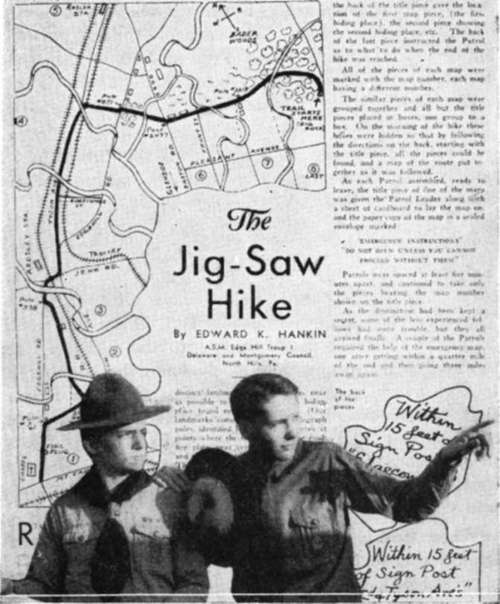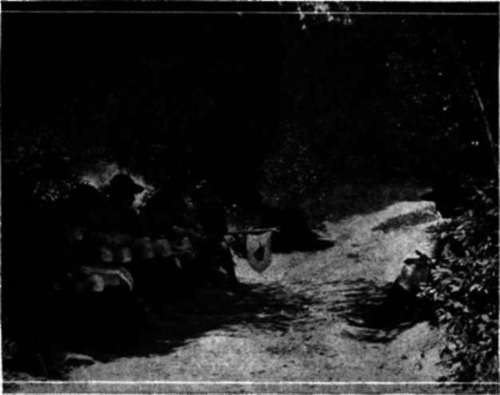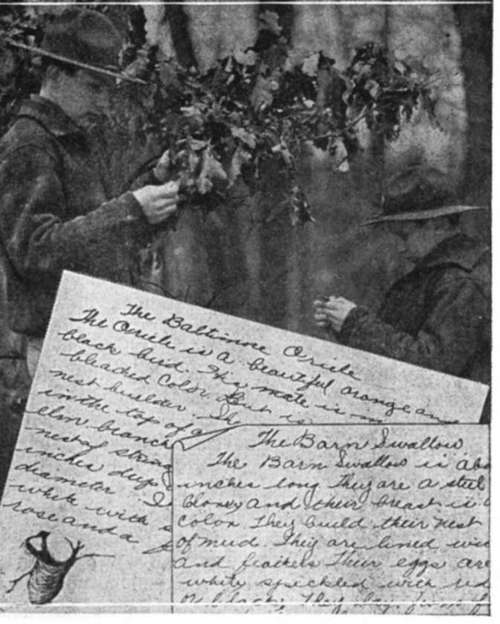1. Planning The Hike
Description
This section is from the book "Handbook For Scoutmasters. Volume 1 & 2", by Boy Scouts of America. Also available from Amazon: Handbook For Scoutmasters.
1. Planning The Hike
But, first, what is a hike?
The Scouting definition for the word "hike" is: "A walk with a purpose." The distance may be short or long, the trip may involve much or little actual tramping—but without a definite purpose behind it, it is not a Scout hike.
And what might that purpose be? It must be more than "to get the boys out into the open, away from the city streets." Each hike should add to the boy's Scoutcraft knowledge, to his power of observation, to his ability to take care of himself, to his appreciation of the world around him.

A "hike" is "a walk with a purpose." Imagination and inventiveness come in to give the adventurous thrills to the hike.
The rural Scout is already "out in the open, away from the city streets" and yet the Scout hike gives him satisfaction equal to that received by the urban Scout. For example, the boy's knowledge, power of observation, ability to take care of himself and his appreciation of the world around him may all be enhanced by a hike to the city for a visit to a museum, a laboratory or an industrial plant.
But "purpose"—didn't we speak of that in another connection? We did. It was one of the three points which we found imperative for the success of all Scouting activities:
Action Variety Purpose
Of course, you cannot have a hike without action. The very word suggests motion. But "there and back" is not all. Variety must enter into the picture. It is too late to sit up and take stock when the boys begin to stay away in droves and present for their reason that "we never do anything but walk out, light a fire, cook supper and walk home again." Troop hikes, to serve our objectives and our aims with the boys, must be made so interesting and varied that no one will willingly miss them.
Which is only another way of stating that they must be well-planned and well-executed!
In our consideration of plans for the hike it will simplify matters to use the same formula suggested in the Handbook for Patrol Leaders:
What?
In the early days of a Troop's life, most of its hikes will have for their objective the training of the boys in specific Scoutcraft subjects in an effort to help them in their onward journey through Scouting. This outdoor training supplements the preparatory training given at Troop meetings. The hikes will be simple affairs, with observation games on the outward trek, with fire building and the preparing of a simple meal, axemanship and signaling upon arrival at a suitable spot, and a return trip with possibly nature study along the route.

In the open, Scouting precepts take a sturdy hold. On hikes, the preparation done indoors takes on new significance and reality.
As the Troop grows up, the feature of its hikes will be the application of the Scoutcraft knowledge gained on the earlier excursions. There will be no elementary signaling, but the use of signaling to send the Patrols scurrying on different projects. There will be no formal first aid instruction, but the Patrols will come upon staged "accidents" that require their immediate attention. There will be no "first steps in the use of the axe," but bridges to be built to cross a river or a shelter to be constructed on a "Pioneer Hike." There will be no "know the sixteen principal points of the compass," but a Columbus hike, a cross-country trek with the use of the compass only. Or a multitude of Scoutcraft subjects may be incorporated into a Treasure Hunt, a Mystery Hike, an Obstacle Hike.
It will be up to the Hike Committee to decide upon the type of hike—keeping in mind the ability of the Patrols and the individual Scouts, how the hike may best advance the Troop, and the season of the year— and to build into the program a number of those activities that spell a successful outing.
Requisites Of A Hike
The following are the requisites that should be kept in mind when a hike is being planned (cf. Requisites of the Troop Meeting, Chat 27):
PREPARATION—in various phases of Scoutcraft and hiking technique. This may involve:
Demonstrations — by Scouts, leaders, outsiders, prior to the Scout's own experimentation, in such subjects as firebuilding, hike cookery, signaling, etc., using the actual material in the proper setting.
Experimentation—by Scouts to gain actual, thorough training in subjects demonstrated, explained, or about which they may have read.
Examination—in the subjects that constitute the Scout Requirements.
APPLICATION—making use of Scoutcraft learned, thus acquiring further practice, in one or several of the following manners:
Hikes With A Purpose
For detailed suggestions about each of these hikes, see the concluding pages of this Chat
Purpose—The Development of: | Type of Hike |
Patriotism | Historical Hike Patriotic Pilgrimage |
Nature Appreciation | Nature Lore Hike Collecting Hike Star Hike Hunt the Orchid |
Observation | Hare and Hounds Explorers Treasure Hunt Industrial Hike Institutional Hike |
Physical Fitness | Long Distance Hike Swimming Hike Mountain Climb |
Self Reliance | Jack Knife Cookery Hike Starvation Hike |
Scout Spirit | Rovering Knights Conservation Hike "Lost Child" Hike |
Pluck | Wide Game North Pole Race Bee-line (Columbus) Hike |
Scoutcraft * Knowledge | Map Hike Signal Hike First Aid ("S.O.S.") Hike Scoutcraft Obstacle Hike Sealed Orders Hike |
Friendship | Visiting Troop Hike Father-and-Son Hike Reunion (Old Timers') Hike |
Some of the hikes mentioned above fall under various classifications but appear under the heading of the main emphasis. Several of the emphases may, of course, be incorporated into one hike.
Outdoor "Living" — applying knowledge gained toward personal comfort in the woods, i.e. using axe-manship and knotting for the building of shelter, fire-making and cooking for the preparing of a needed meal.
Scouting Games—involving Scout Requirements and use of the senses.
Contests—between Patrols or Patrol Representatives — against specified standards, against time, against teams, against record of self.
RECREATION—for variety. Recreational Games—physical fitness and fun. Songs and Yells—on the road, to shorten the way and to build morale.
INSPIRATION—to keep the ideals of Scouting ever before the boys.
Camp Fire—with a balanced program of songs, yells, story telling, stunts, inspirational talk by the Scoutmaster, etc. (Also provides recreation.)
Ceremonies — investiture and advancement ceremonies with an outdoor setting.
Natural Occurrences—may provide real inspiration. They are mentioned here although they cannot be planned for, to keep the leaders alert to their value. In this category may be considered %an especially colorful sunset, a rainbow, a distant storm, reflections on a quiet lake, etc., which when brought subtly to the boys' attention may affect them deeply.
ADMINISTRATION—should be kept down to the irreducible minimum.
Reports—by the Patrol Leaders before the start of the hike, as to attendance.
Inspection—check on needed equipment and suitability of clothing.

Leaves and birds and nests and all nature become open books as Scouts develop latent powers of observation, while hiking.
Announcements — needed explanations as to the activities of the hike.
From the above requisites the members of the Hike Committee will choose certain items, build them into a skeleton hike program and clothe this with the flesh and garments of their imagination. It is, after all, IMAGINATION which turns the Troop's outing into an exciting experience for the boys and prevents it from being "just another hike."
Continue to:


